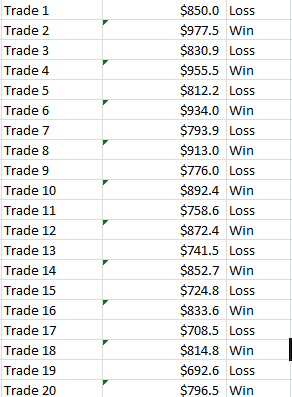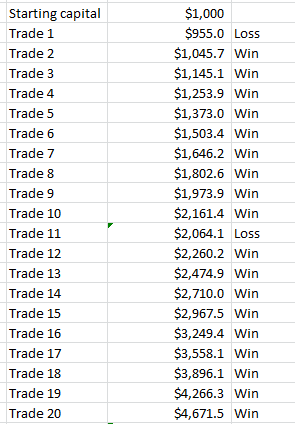High Probability Swing Trading Strategies
Over the past few months on the blog, we have been identifying and explaining the high probability swing trading strategies this year so far in our Daily Alert service. Some of these include trading triangles and explosive bottoming patterns.
There are a lot of decent swing trading strategies discussed online. Double bottoms and high tight flag breakouts within multi-year uptrends are 2 good examples.
However, you generally need to have a more specific set of screening criteria to really have a high probability swing trading strategy.
For instance, the high tight flag breakout is one of the best strategies we use in our own trading with a good win rate and a lot of upside.
However, if you narrow in on just the best opportunities, the strategy has been phenomenal over the past couple years.
Recent Back-test of a High Probability Swing Trading Strategy
In a recent back-test that looked at over 80 high tight flag patterns from December 2017 to August of 2018, the win rate was about 65% with a tight 4% stop while going for nearly twice that as a profit target.
The screening criteria looked at a few other factors besides price action to qualify as a good high tight flag but they were pretty generic and commonly used by experienced traders.
However, if you just look at the ones that also meet several other key criteria at the breakout point, the win rate was nearly 90% with an average max gain of 40% within a few weeks. The really big winners skewed the average max gain but it gives you an idea of the potential of the technical breakout.
Now, a lot of traders do not appreciate the difference between a 60% win rate and a higher win rate. One of the biggest differences is that a 60% rate greatly increases the chances of multiple losing trades in a row. In fact, there will definitely be times where you lose on 4 or more trades in a row with this typical win rate.
This lower win rate will likely yield a large draw-down at some point depending on how you manage your risk in your trading plan.
However, with an 80% to 90% win rate, the chances are MUCH lower for a more damaging drawdown. I have yet to see 3 losing trades in a row on stocks that meet all the requirements in the high, tight flag course at the breakout point that are not recent IPOs (there are better strategies for recent IPOs).
Knowing our high tight flag strategy has a very high win rate gives me a lot more confidence to be aggressive with this strategy.
Here is an illustration of why its so important to get a higher win rate in your trading.
High Probability Swing Trading Strategies and Penny Stocks
I’ll compare the typical win rates that I have seen over the years in back-tests on top patterns on lower priced stocks versus recent back-test results of higher probability strategies on top small to large cap growth stocks and UPOD stocks (under promise/over deliver).
In all of my back-tests, the win rate on stocks under $20 drops by about 10% or more. Below $10 and the win rate is worse.
Not only that, you generally have to take a smaller position size due to the increased risk of a sudden secondary offering, wider bid/ask spreads, trading halt, SEC inquiry, etc. on lower priced stocks. They are also easier to manipulate by email, tweets and chat rooms in both directions with sharp, sudden moves that are impossible to predict.
Just to illustrate how important a higher win rate is when swing trading, lets look at what happens if we have a 50% win rate with a 15% profit and a 15% stop. I use 15% because that is often the type of stop you need on lower priced stocks which are popular among new traders but we generally avoid. Here’s why.

We can see after 20 trades, this would have lost 20% of our trading capital even though we won half the time with the same percent profit as the losses. After 50 trades, we will lose about 50% before commissions and slippage with a 50% win rate.
To break even, we would need at least a 54% win rate with the 15% stop and a 15% profit target. More than that if we include commissions and slippage. Much more if its a small account.
This required win rate only gets higher the wider we make our stop and profit target.
For instance, if we use a 20% stop with a 20% profit target, then our win rate would need to be over 60% just to break even.
The lower the price of the stock, the wider the stop-loss you need generally. This is the problem with trading lower priced stocks because they often drop 15% to 20% or more after reaching a good technical entry point.
Recently, I watched a stock below $5 breaking out of a beautiful high, tight flag pattern and then saw it drop 20% within a few minutes of the breakout. I have yet to see that on the higher priced stocks that meet the criteria in our high tight flag strategy taught in our new course after watching hundreds of these.
As I pointed out above, all of the back-tests we have done on our top technical strategies shows a significantly lower win rate on stocks under $20 and especially under $10. Recent IPOs have a lower win rate as well with all the strategies we have tested.
To achieve a very high win rate, the first step we take is to avoid low priced stocks when developing a strategy. We rarely trade stocks under $10 and the only ones we do have a great long-term uptrend with rapidly improving fundamentals.
Now lets compare the graphic above to a high win rate of 90% with a 4.5% stop and the average profit using our optimized high tight flag strategy back-tested results on higher quality growth stocks.

So even though the average profit is just under 10%, the higher win rate would more than quadruple the account over the 20 trades if we compound the gains (put the profits into the next trade).
Now one back-test over an 8 month period does not mean it will work this well going forward. However, during a period where we saw 2 corrections on the Nasdaq (Yes, there were technically 2 in the first half of 2018), its a good enough proving ground to start using it more for this trader.
Why High Probability Trading Strategies Matter
High win rates matter more than you think even if you have to shoot for a smaller target. A win rate over 80% starts to look very good while back-testing over a few dozen trades. We try to make sure we are getting the highest win rate possible with more upside than downside while using a tight stop.
To get a higher win rate with your strategy, you can begin to look at key factors present at the technical entry point. Things such as changes in volume, short interest, a new catalyst, strong market rebound on a market catalyst along with a whole host of other factors discussed in our courses and alert service.
Also, certain times of year like mid to late summer and around the holidays usually see lower win rates but could offer a good entry after a short-term trend reversal has been confirmed for a trade you are stalking.
It seems every year we have some of our biggest winners featured to clients just before the new year. This year it was TTD and NOW that made great moves this year so far. TTD had a strong reversal pattern that developed towards the end of the slower holiday period.
The more important point of a higher win rate is that it makes major drawdowns less likely. We have yet to “blow up an account” or even come close using good strategies on higher quality growth stocks in great multi-year uptrends.
So be sure to carefully monitor your win rate over time and compare the win rates of different strategies in the current market conditions. Here are articles on 2 of our favorites right now with higher win rates versus others we trade.
Our #1 Momentum Setup: Our Optimized High Tight Flag Strategy
Trading Big Earnings Beats: Our Earnings Eruptions Strategy







